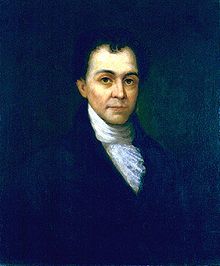Paul Hamilton (politician)
| Paul Hamilton | |
|---|---|
 |
|
| 3rd United States Secretary of the Navy | |
|
In office May 15, 1809 – January 1, 1813 |
|
| Appointed by | James Madison |
| Preceded by | Robert Smith |
| Succeeded by | William Jones |
| 42nd Governor of South Carolina | |
|
In office December 7, 1804 – December 9, 1806 |
|
| Lieutenant | Thomas Sumter, Jr. |
| Preceded by | James Burchill Richardson |
| Succeeded by | Charles Pinckney |
| 1st South Carolina Comptroller of Finance | |
|
In office 1799 – 1804 |
|
| Governor |
Edward Rutledge John Drayton James Burchill Richardson |
| Preceded by | Position established |
| Succeeded by | Thomas Lee |
| Member of the South Carolina Senate from St. Bartholomew's Parish | |
|
In office November 24, 1794 – December 21, 1799 |
|
| Member of the South Carolina House of Representatives from St. Paul's Parish | |
|
In office January 1, 1787 – January 5, 1789 |
|
| Personal details | |
| Born |
October 16, 1762 Saint Paul's Parish, South Carolina |
| Died | June 30, 1816 (aged 53) Beaufort, South Carolina |
| Political party | Democratic-Republican |
| Spouse(s) | Mary Wilkinson |
| Profession | Politician, Farmer |
| Military service | |
| Service/branch | Continental Army |
| Battles/wars | American Revolutionary War |
Paul Hamilton (October 16, 1762 – June 30, 1816) was the 3rd United States Secretary of the Navy, from 1809 to 1813.
Paul Hamilton was born in Saint Paul's Parish, South Carolina, on October 16, 1762. He left school at the age of sixteen due to financial problems. During the American War of Independence he served actively in military roles in the southern states, fighting under General Francis Marion. He participated with Colonel William Harden in the capture of Fort Balfour.
Following the war, he was a planter and public figure. Hamilton served South Carolina in many public offices including state Representative (1787), State Senator (1794), Comptroller (1800), and the 42nd Governor (1804).
In 1809, President James Madison selected Hamilton to become the third Secretary of the Navy. His term in office included the first months of the War of 1812, during which time the small United States Navy achieved several remarkable victories over British warships. Hamilton was a proponent of military preparedness, especially sea fortifications. Although he wanted to strengthen the Navy, he found the Congress hostile and the President indifferent to his ideas. However, he was responsible for the Naval Hospitals Act of 1811. Secretary Hamilton resigned at the end of 1812 and returned to South Carolina, where he died in Beaufort on June 30, 1816.
Three Navy destroyers have been named USS Paul Hamilton in his honor along with the USS Hamilton (1809) and one Liberty ship named SS Paul Hamilton. Also bearing his name is the town of Hamilton, Georgia.
...
Wikipedia
